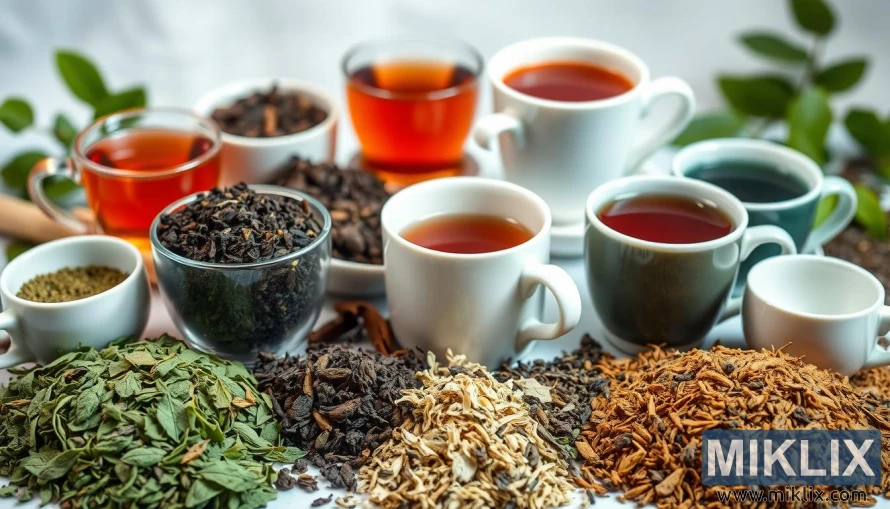Image: Diverse tea leaves and brewed teas
Published: May 16, 2025 at 12:24:58 PM UTC
Last updated: September 25, 2025 at 8:20:58 PM UTC
Vibrant display of green, black, oolong, white, and herbal tea leaves with traditional teacups, highlighting tea's variety, beauty, and health benefits.
The scene unfolds like a celebration of tea in all its diversity, a visual symphony of textures, colors, and aromas carefully arranged to highlight the richness of this timeless beverage. In the foreground, an artful display of loose tea leaves stretches across the frame, each pile distinct in hue and form, revealing the incredible variety offered by nature and perfected through centuries of cultivation and craftsmanship. There is the fresh, almost emerald vibrancy of green tea leaves, still carrying the essence of the gardens from which they were plucked. Beside them, the dark, twisted clusters of black tea stand in stark contrast, their earthy tones suggesting depth, boldness, and strength. Nearby, oolong leaves, half-fermented and curled into intricate shapes, embody balance—neither as light as green nor as robust as black, but existing gracefully between the two. Pale, delicate strands of white tea lie in gentle disarray, their fragile structure capturing the purity of the young buds from which they are derived. Interspersed among these are herbal blends, each carrying their own identity and therapeutic promise, their colors and textures a testament to the plants beyond the tea tree that have long been part of human rituals of health and comfort.
Rising behind this abundant spread are cups of brewed tea, each vessel chosen with care to enhance the diversity of the scene. The glass cups gleam with clarity, their transparency allowing the rich amber and golden hues of the teas to shine as though illuminated from within. The porcelain cups, smooth and elegant, hold deeper shades—burnt orange, russet, and crimson—each brew revealing the complexity extracted from its leaves. Ceramic mugs in muted, earthy tones contribute a grounding presence, evoking tradition and the humble comfort of tea shared in everyday life. Together, these vessels capture the full spectrum of tea’s character, from delicate and floral to bold and malty, from grassy freshness to smoky depth. The careful placement of the cups allows the eye to wander naturally from one to the next, as though embarking on a journey across cultures and flavors, guided by the color and transparency of the liquid within.
The backdrop, softly blurred, offers a sense of serenity and contemplation, ensuring that the focus remains on the teas themselves while subtly reinforcing the calm atmosphere tea so often creates. The diffused lighting bathes the entire arrangement in warmth, enhancing the natural colors of the leaves and liquid. It is not harsh or dramatic but gentle, as if replicating the soft glow of morning light filtering through a window, the kind of light that invites one to sit quietly with a cup and reflect. The few hints of green foliage in the background provide a reminder of origin, connecting the final brewed teas back to the living plants and fertile soils from which they began.
The overall composition conveys a narrative that is both universal and deeply personal. It speaks of tea not just as a beverage but as an experience, one that spans continents, traditions, and centuries. Each pile of leaves tells a story of careful harvests, of hands that have rolled and dried them, of climates and landscapes that have shaped their flavor. Each cup, steaming gently, represents a different mood, a different moment in the day, or a different need of the body and mind—whether it be the clarity of green tea in the morning, the boldness of black tea in the afternoon, or the calming touch of herbal infusions in the evening. Beyond taste, it conveys the healthful benefits long associated with tea: antioxidants, digestive support, calm focus, and the simple act of slowing down.
This image, abundant and balanced, becomes more than a still life; it is a celebration of diversity within unity. It invites the viewer to appreciate both the individuality of each variety and the collective harmony they form together. Tea is shown here as a universal connector—ancient yet ever-renewing, humble yet profound, familiar yet endlessly complex. It is an invitation to pause, explore, and savor the many forms this single leaf can take, each one a unique expression of nature, tradition, and human care.
The image is related to: From Leaves to Life: How Tea Transforms Your Health

